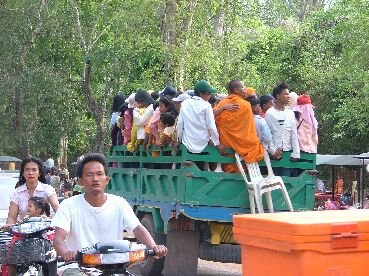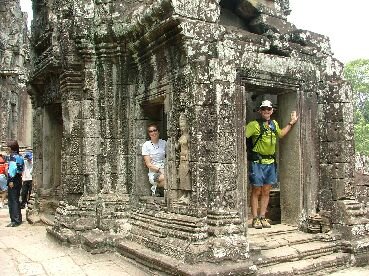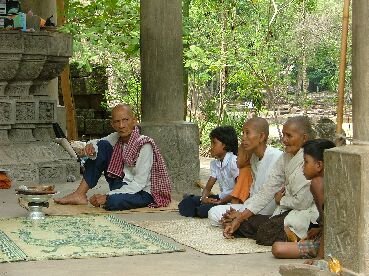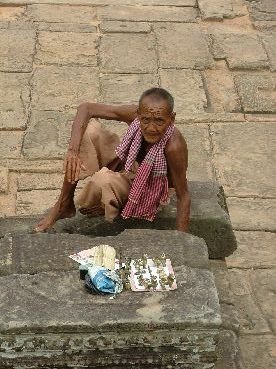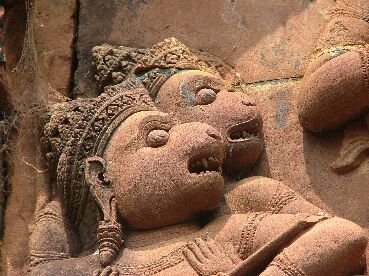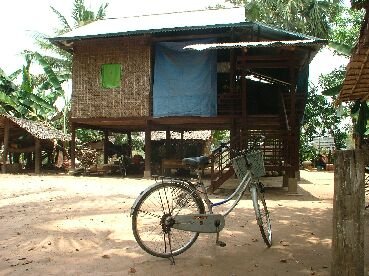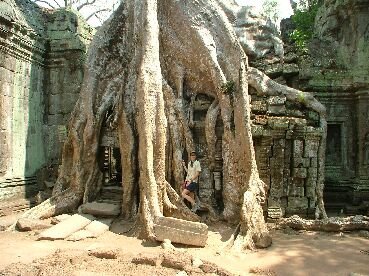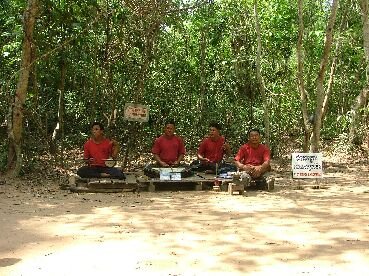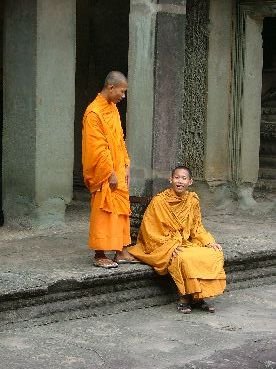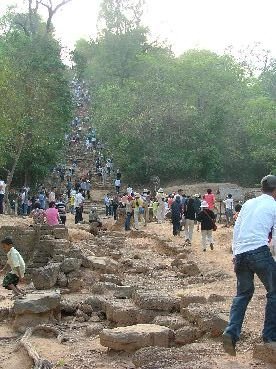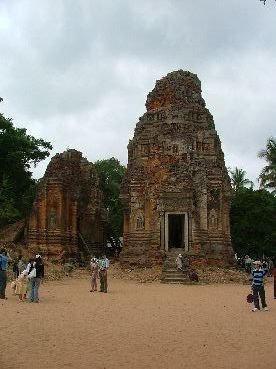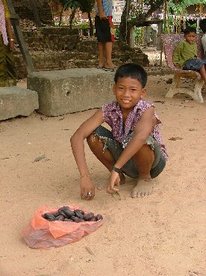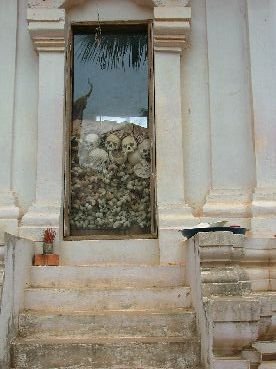|
|
WhereAreJanetandRick Cambodia |
|
The Temples of Angkor
Angkor Thom
Angkor Thom is the inner royal city, built by the end of the 12th century during the reign of King Jayavarman VII, shortly after Angkor had been conquered and burnt down by the Chams. This inner royal city was built as a quadrangle and bordered by a 100-metres-wide moat and an 8-metres-high wall. Angkor Thom is geometrically oriented: it covers an area which is an exact quadrangle; the sides of this quadrangle run exactly in North-South and East-West direction. A gate opens exactly in the middle of each wall, connecting, through a bridge over the moat, the royal city with the outside.
It appears that the 12th century architects did not anticipate motor vehicles using their gates. Note the monk in the truck bringing his own chair to the festivities.
Cambodian man selling souveneirs at the temple. The checkered scarf that he's wearing is called a krama and is quintessentially Cambodian. Kramas, made from cotton or silk, are most commonly found in red or blue check and have a variety of uses. Each province produces its own patterns. Kramas are also used to carry babies, kittens, chickens or for shopping, and to cover pillows, beds and chairs. They serve as hammocks for babies, can be strung across the hoops of a cyclo to rest a tired driverís head, they are perfect cushion on the head before placing large trays of goods to carry to markets. In some villages almost every family has a loom, producing fine cotton and silk kramas. They sell the kramas in nearby markets. The tradition probably dates back to Angkor.
Banteay Srei Temple
Banteay Srei, the "Citadel of the Woman", was constructed during the reign of King Rajendravarman by one of his ministers, Yajnyavaraha, who served as tutor to the future king Jayavarman V. It was built on land given to him by the king that lies about 23 kilometers northeast of Angkor. The carvings and architectural details in this pink sandstone temple are some of the finest of Khmer art.
TA Prohm
TA Prohm was built during the reign of Jayavarman VII, a great king who reconquered the Khmer empire from Cham invaders in the years 1177-1181. Needless to say, the war caused great damage to the ancient capital of Angkor. The ambitious king set about making it into a proper seat of power by ordering the reconstruction of a number of temples. TA Prohm was the centerpiece of his masterplan, located roughly in the center of the capital. Though the temple covers barely 2.5 acres, its walls and moat encompass 148 acres, which would have sheltered a town attached to the temple. Here, 12,640 people lived, supported by a population of 79,365 who worked in nearby villages to provide food and supplies.
TA Prohm housed the deity Prajnaparamita, the "perfection of wisdom." It was consecrated in 1186. Like many Khmer kings, Jayavarman had it carved in the likeness of his mother. The Prajnaparamita statue was surrounded by 260 lesser divinities, housed in their own sanctuaries. Interestingly, the temple was also the headquarters of a vast hospital network created by the good king. From TA Prohm, supplies filtered out to 102 hospitals located throughout the empire. The Khmer kings seem to have taken the Buddha's call to mercy into their own hands. Nowadays, TA Prohm is in a sad state of disrepair. Voracious trees called Strangler Figs have damaged much of the complex. Those who have seen the Lara Croft/Tomb Raider series may recognize that parts were filmed at Ta Prohm.
It is not uncommon to see victims of war in Cambodia. These land mine victims played music outside of Ta Prohm.
Angkor Wat
Angkor Wat (see picture in Introduction) was certainly one of the main events on our tour. It is a spectacular temple built by the vanished Khmer empire. It was constructed during the reign of king Suryavarman II, who ruled from 1113 to at least 1145. In those days, it was customary for the Khmer Empire to maintain a state temple at the heart of the city. However, when Suryavarman assumed power, the existing Baphuon state temple was dedicated to Shiva. Suryavarman worshiped Vishnu, and wished to honor him with a new temple south of the existing capital. This new state temple came to be called Angkor Wat, meaning "The city that is a temple."
Pictured here is a woman outside of the Angkor Wat temple complex, probably looking for a place to set up her food stand. The road was crowded with pilgrims in cars & trucks, on bicycles and motorscooters, and on foot. There was the usual hustle and bustle of crowds - people walking, talking, picnicing, food stalls, souveneir stalls, elephant rides ...
Phnom Bakheng Temple
The Phnom Bakheng Temple is a little north and east of Angkor Wat. You can climb up the hill to the temple, or take an elephant. It's particularly popular at sunset.
Lolei
Yasovarman I built a sanctuary consisting of four temples in the centre of the lake made by his father. The sanctuary was consacrated in 893. The temples were dedicated to his deceased parents and his deceased maternal grandparents. At present the two temples on the left are in ruins.
Adjacent to the Lolei ruins is a modern Theravada buddhist monestary. During our visit over the New Years period, resident monks had organized playful activities for local children. Pictured here is a young boy with a bag of seeds used to play a game similar to jacks. It looks like he's whooped all of his buddies as no one else is willing to take up the challenge.
The Killing Fields
Cambodia was sucked into the Vietnam conflict. On April 17, 1975, the Khmer Rouge took the capital, Phnom Penh, and under their leader, Pol Pot, implemented one of the most radical, brutal revolutions that the world has ever seen. 'Year Zero' was proclaimed and Cambodia was to be transformed into a Maoist peasant dominated agrarian cooperative. Almost 2 million Cambodians died between 1975 and 1979 as a result of the policies of the Khmer Rouge government. Many of these were educated and non-farmers. Looking at the ages of the people that we saw, it was chilling to see a generation almost missing. We met people who had relatives disappear, never to be seen again; people who at age 10 were taken from their remaining families and forced to work on farms. The psychological scars are still evident.
Notwithstanding this brutal history, we received some of the warmest smiles in Cambodia.
This is a temple and monestary adjacent to the Killing Fields Monument.
| |||||||||||||||||||||||||||||||
